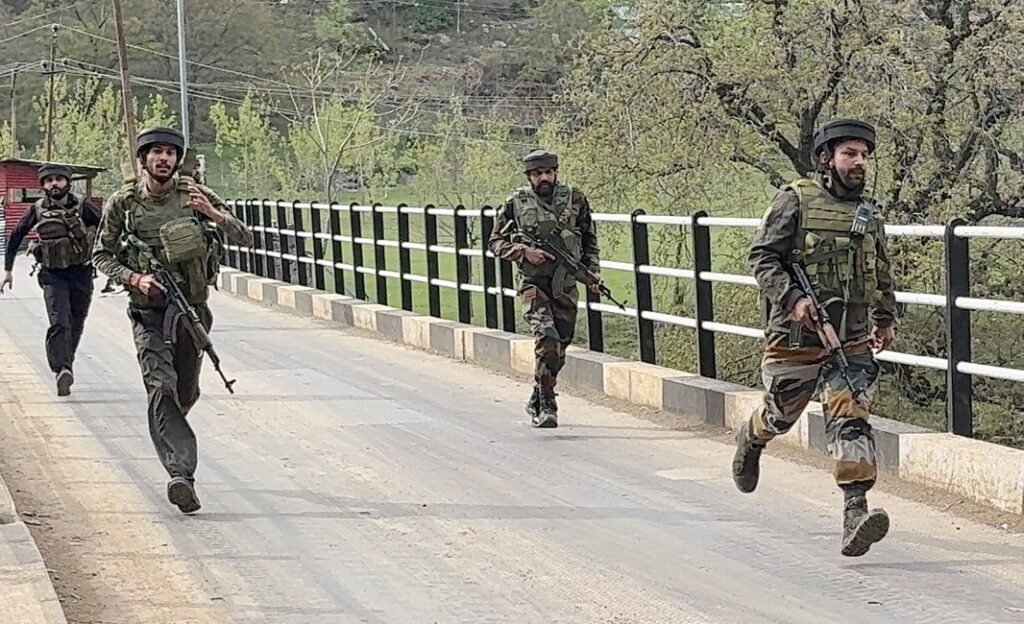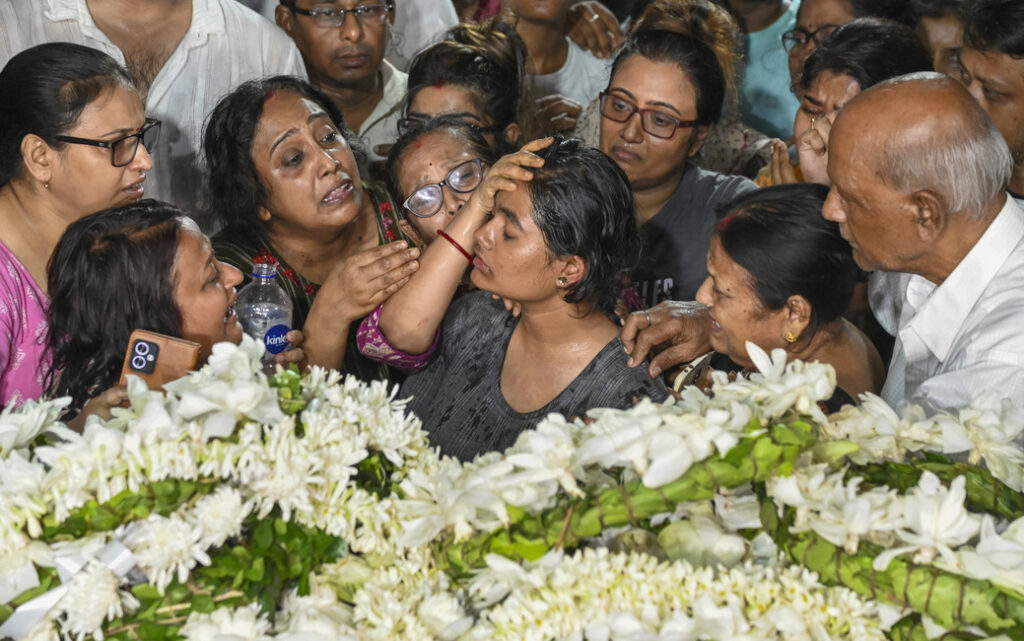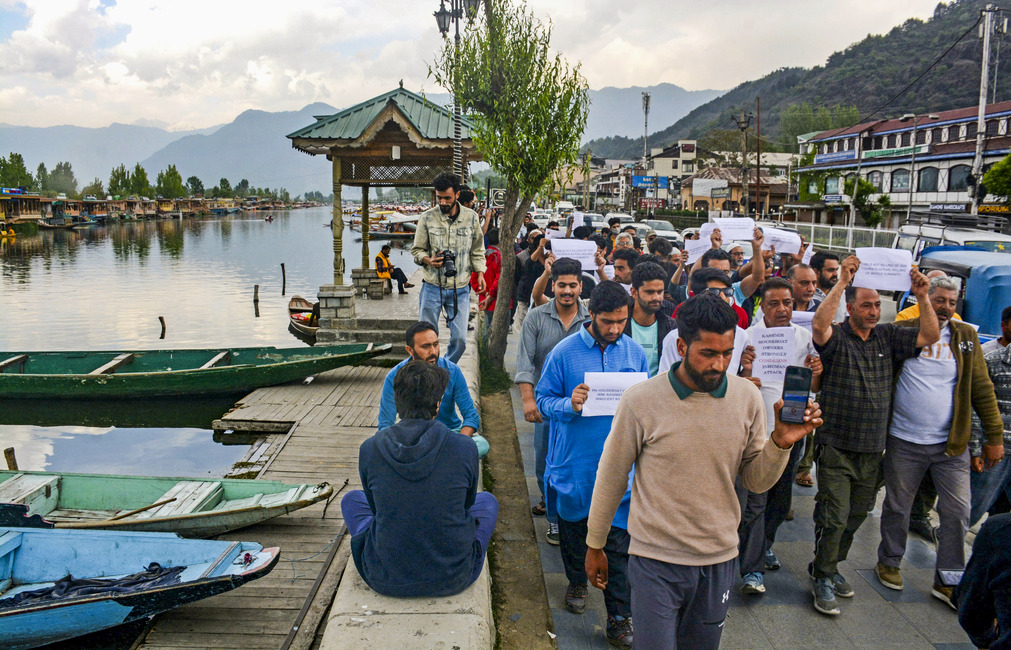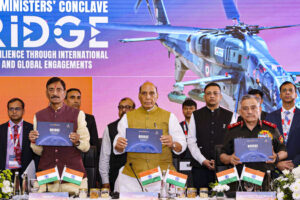
Security forces rushing to Baisaran after terrorists belonging to The Resistance Front gunned down 26 people—mostly Hindus tourists .
The Pahalgam terror attack rudely shattered the assiduously built peace initiative that saw a semblance of normalcy returning to Jammu and Kashmir with economic activity led by tourism picking up. It will take a long time to regain the confidence of the people
The peaceful and quiet Baisaran meadow in Pahalgam, Jammu and Kashmir, was stained with blood on April 22 in a devastating terror attack that shook the nation.
But this act of violence was not just another attack; it represented a grim turning point in the region’s fragile journey toward peace. What unfolded was not merely a terror attack on innocent civilians, who were there just to enjoy the beauty of Baisaran; it was a blow to Kashmir’s hope—to its hard-earned comparative peace, its recovering economy and, above all, the resilience of Kashmiris who have been bearing the brunt of violence and terrorism for over three decades.
The attack also struck at the heart of the Modi government’s carefully cultivated “peace narrative,” which has consistently asserted that complete peace and normalcy had been restored in Jammu and Kashmir following the abrogation of Article 370 in August 2019. Exactly a month before the brutal terror strike in Pahalgam, on March 22, Union Home Minister Amit Shah, addressing the Rajya Sabha, proudly stated the government’s “zero tolerance policy towards terrorism.”
He sharply criticised the previous UPA administration for its alleged leniency on terror and credited key decisions particularly the removal of Article 370—for ushering in what he described as “lasting peace” in the region. That very narrative was shattered on the blood-soaked meadow of Baisaran on April 22.
The terror attack also raised some pressing questions about the security agencies. The most important question is: how were terrorists present in a prime tourist location, which also serves as a route to the Amarnath Cave, which lakhs of pilgrims are supposed to visit in a few months? Why were no security personnel stationed at the meadow? And why have mobile phone towers still not been installed in Baisaran and its surrounding areas, leaving the region in a communication blackout Evidently, the security agencies were unaware of the militants’ presence in this strategically crucial area. Had there been any intelligence or preventive deployment, the terrorists might not have succeeded in carrying out the horrific massacre of 26 innocent visitors.
This attack has posed serious challenges to the security agencies. The immediate challenge before them is to ensure peaceful and smooth conduct of the annual Amarnath Yatra, scheduled to take place from July 3 to August 9. Last year, more than five lakh pilgrims visited the holy cave. This year, in view of this attack, the number of pilgrims might be less; however, restoring a sense of security among them will be a formidable task for the security agencies.

PM Narendra Modi called an emergency meeting of the Cabinet Committee on Security on April 23 to assess the situation and determine the course of action in responding to the terror attack, reportedly linked to to the Pakistan-based Lashkar-e-Taiba
The attack has posed serious challenges to the security agencies. The immediate challenge before them is to ensure peaceful and smooth conduct of the annual Amarnath Yatra, scheduled to take place from July 3 to August 9
The long-term challenge for security agencies now lies in restoring public confidence, as this attack has severely disrupted the fragile peace in the Valley. As news of the deadly terror strike spread, tourists present in the region panicked and began to flee. Bookings for the upcoming weeks and months were swiftly cancelled. In a single blow, the region’s recovering tourism industry—estimated to generate over Rs 12,000 crore annually and serving as a livelihood for a large segment of the Kashmiri population—crumbled like a house of cards. The most daunting task ahead will be to rebuild trust among potential visitors and persuade them to return to the Valley—undeniably an uphill task.
Since the victims hailed from 14 states of India—namely, Maharashtra, Gujarat, Karnataka, Uttar Pradesh, West Bengal, Tamil Nadu, Kerala, Haryana, Madhya Pradesh, Odisha, Telangana, Arunachal Pradesh, Andhra Pradesh, and Chhattisgarh and the Union Territory of Chandigarh, and from Nepal, the aftermath of the tragedy has had wide ripples. Its impact will be long lasting, and persuading both domestic and international tourists to visit Kashmir again will not be easy.
Acknowledging the profound impact on the tourism industry, Chief Minister Omar Abdullah described the exodus of tourists as “heartbreaking”. He wrote on X: “It’s heartbreaking to see the exodus of our guests from the Valley after yesterday’s tragic terror attack in Pahalgam but at the same time we totally understand why people would want to leave.” Beyond its immediate impact on Jammu and Kashmir’s economy, this terror attack might be an indication of more violence in the near future. Just a day after the Pahalgam incident, the Indian Army neutralised two heavily armed terrorists during an ongoing counter infiltration operation in Sarjeevan area near Uri Nala, along the Line of Control in North Kashmir’s Baramulla district. This indicates the continuing sponsorship of terrorism from across the border.
The Resistance Front (TRF), a proxy outfit of the Lashkar-e-Taiba, has claimed responsibility for the Pahalgam attack. Notably, the TRF emerged in October 2019, just months after the Central government revoked Article 370. If media reports quoting intelligence sources are to be believed, Kashmir is facing a new breed of militancy.
Intelligence estimates suggest that approximately 60 foreign terrorists are currently active in the Valley, with nearly half believed to be affiliated with the TRF.


Grieving relatives of a victim. (Right) Residents of Srinagar on a protest march against the terror attack
Some analysts believe that the handlers of the terrorists who carried out the Pahalgam attack had planned it strategically, as it occurred during the four-day visit of US Vice President J.D. Vance to India
Some analysts believe that the handlers of the terrorists who carried out the Pahalgam attack had planned it strategically, as it occurred during the four-day visit of US Vice President J.D. Vance to India. A similar pattern was observed in March 2000, when terrorists attacked and killed 36 civilians from the minority Sikh community in Chattisinghpora village in Anantnag district, coinciding with the visit of then US President Bill Clinton to India. If this is not a coincidence, it suggests that the Pahalgam terror attack had the backing of handlers who meticulously plan such operations. This makes the situation all the more dangerous.
Apparently, Kashmiris—who have witnessed death, destruction, and bloodshed on their land for decades, and who have borne the brunt of violence for over three decades—seem to be well aware of the intensity of the fallout of the Pahalgam attack.
They understand that this attack will have repercussions for a long time, and that people will have to suffer in terms of increased security vulnerabilities, economic losses, and other challenges.
This is why the people have been mourning the tragedy with an intensity not seen before. The region witnessed unequivocal condemnation, complete shutdowns across Jammu and Kashmir, and widespread protests in response to the brutal attack. In a poignant display of solidarity and grief, several Kashmiri newspapers published black front pages, with stark white or red headlines, capturing the collective anguish over the dastardly attack.
The Pahalgam terror attack has laid bare deeper vulnerabilities, heightened insecurities, and intensified challenges for all stakeholders—the Central government, the Union Territory administration, security forces, and the people of Jammu and Kashmir. Addressing this crisis requires the formulation and execution of a renewed strategy grounded in proactive measures. Beefed-up security, better communication systems, and support from the local people will be key. Most importantly, efforts must be made to rebuild trust among Kashmiris and among the people in the rest of the country. Only then can Kashmir begin to heal and move on.





Add Comment